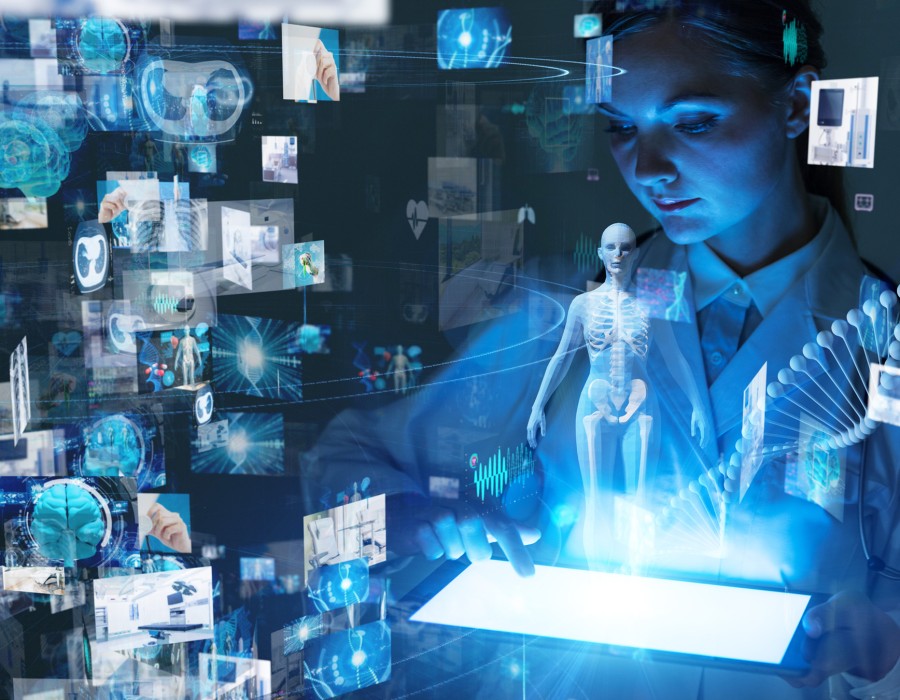Introduction:
The global medical simulation market is anticipated to achieve a value of US$ 2,099.7 million by 2023, exhibiting an estimated CAGR of 13.5% during the forecast period, eventually reaching US$ 7,471.1 million by 2033. As of 2022, the market was valued at US$ 1,876.4 million.
Applications of the Medical simulation market involve replicating in-person activities in a virtual environment for training, feedback, and experiential learning. This technology, utilized by healthcare professionals like physicians, nurses, surgeons, and others, enables them to learn, practice, and assess their skills in a secure environment.
Medical simulation employs body manikins, task trainers, and virtual reality (VR)-based systems for various simulations such as laparoscopic, gynecological, cardiovascular, arthroscopic, spinal, endovascular, dental, and eye simulations. It gathers feedback from observers like professors, peers, actor-patients, and video cameras, contributing to enhancements in patient safety, communication, and crisis management systems.
Simulation training played a pivotal role during the pandemic, utilized in healthcare institutions to refine protocols, identify safety gaps, and train redeployed healthcare workers in unfamiliar roles. The medical field's technological advancements have increased the demand for simulation, especially with the introduction of medical devices and advanced procedures like Intra-Cardiac Echocardiography (ICE), cardiac assist devices, and mechanical ventilation enhancements, necessitating advanced training solutions such as simulation.
Key Market Growth Factors and Dynamics Medical Simulation Market:
Technological Advancements: Ongoing technological progress in the medical field, introducing new devices and sophisticated procedures, creates a demand for advanced training solutions like medical simulation.
Training Requirements for Complex Procedures: Increasing complexity in medical procedures necessitates realistic and sophisticated training methods, fueling the adoption of medical simulation.
Patient Safety and Skill Enhancement: Medical simulation allows healthcare professionals to enhance their skills in a safe environment, contributing to improved patient safety and quality of care.
Pandemic Response and Preparedness: The COVID-19 pandemic emphasized the importance of simulation training in refining protocols, identifying safety gaps, and preparing healthcare workers for various scenarios.
Experiential Learning: The hands-on and immersive experience provided by medical simulation is a significant factor in its adoption, allowing practitioners to practice and assess their skills effectively.
Continuous Professional Development: The need for continuous professional development in the healthcare sector drives the demand for simulation training to stay updated on the latest practices and technologies.
Global Industry Analysis, Size, Share, Growth, Trends, and Forecast 2023-2032 – By Product Type, Application, End-user, and Region: (North America, Europe, Asia Pacific, Latin America and Middle East and Africa): https://www.persistencemarketresearch.com/market-research/medical-simulation-market.asp
Market Restraints and Challenges Medical Simulation Market:
High Initial Costs: The substantial initial investment required for implementing medical simulation systems, including equipment, software, and training programs, may deter healthcare institutions, particularly those with budget constraints.
Budget Constraints in Healthcare Institutions: Tight budgets in healthcare institutions, especially in resource-limited settings, pose a challenge to the widespread adoption of medical simulation technology.
Limited Funding for Simulation Programs: Despite recognized benefits, limited funding for simulation programs hinders their development and expansion within healthcare organizations.
Integration Challenges: Integrating medical simulation technology with existing healthcare systems and curricula can be challenging, with compatibility issues and resistance to change within established workflows.
Lack of Standardization: The absence of standardized guidelines for medical simulation can lead to variations in program quality, emphasizing the need for consistency.
Technological Complexity: The complexity of medical simulation technology may act as a barrier, especially for smaller healthcare facilities with limited technical expertise.
Limited Accessibility in Emerging Markets: Emerging markets may face challenges in accessing and adopting medical simulation due to infrastructural limitations and a shortage of skilled personnel.
Market Mergers & Acquisitions:
Industry Consolidation: Larger healthcare and technology companies may acquire smaller firms specializing in medical simulation, consolidating their position in the market.
Diversification of Product Portfolios: Mergers and acquisitions aim to diversify product portfolios by integrating various simulation technologies, software solutions, or training programs.
Entry into New Markets: M&A activities enable companies to enter or expand their presence in new geographic markets, facilitating market penetration and growth.
Technology Integration: Acquisitions may focus on integrating cutting-edge technologies into existing medical simulation solutions, enhancing realism and effectiveness.
Strategic Partnerships for Innovation: Partnerships with technology startups can foster innovation and the development of novel simulation technologies.
Enhanced Educational Offerings: Mergers and acquisitions seek to enhance educational content and training programs by acquiring institutions or content creators specializing in healthcare simulations.
Access to Intellectual Property: Acquiring companies may seek valuable intellectual property, patents, or proprietary technologies from smaller players for a competitive advantage.
Meeting Regulatory Compliance: Acquisitions may ensure compliance with evolving regulatory standards in the healthcare and simulation industries.
Future Outlook Development:
Advancements in Simulation Technology: Ongoing improvements in virtual reality (VR), augmented reality (AR), and haptic feedback systems aim to enhance the realism and effectiveness of medical simulations.
Integration of Artificial Intelligence (AI): The incorporation of AI in medical simulation is expected to grow, offering more intelligent and adaptive simulations based on individual learner performance.
Remote and Telehealth Training: Simulation tools supporting training in virtual or remote environments will see increased development to align with the growing adoption of telehealth and remote healthcare services.
Interdisciplinary Simulations: Collaborative simulations involving healthcare professionals from various disciplines will become more prevalent, enhancing teamwork and communication skills.
Expanded Use in Non-Clinical Settings: Medical simulation applications will expand beyond clinical settings to include non-clinical environments, addressing healthcare management, leadership training, and communication skills development.
Global Accessibility and Affordability: Efforts will focus on making medical simulation more accessible globally, addressing challenges related to affordability and technology infrastructure in emerging markets.
Data Analytics and Assessment Tools: Future developments may integrate data analytics tools to track and assess learner performance during simulations, providing insights for tailored training programs.
Key Players: CAE Inc., Mentice, Gaumard Scientific, Limbs & Things LTD, 3D Systems, Intelligent Ultrasound, Kyoto Kagaku, Operative Experience, Inc., Synaptive Medical, 3B Scientific, Laerdal Medical, VRmagic Holding AG
Key Segments of Medical Simulation Market:
Product & Service:
Models/Simulators: Physical representations used for medical simulations, including anatomical models and patient simulators.
Healthcare Simulation Anatomical Models: Detailed anatomical models designed for medical training purposes.
Patient Simulators: Lifelike manikins that mimic human physiological responses for realistic training scenarios.
Task Trainers: Specific simulation tools focusing on individual medical tasks or procedures.
Simulation Training Services: Educational services related to simulation training, including offerings from educational societies and custom consulting services.
Technology:
Low-fidelity Medical Simulation: Simulations with basic features, suitable for introductory or fundamental training.
Medium-fidelity Medical Simulation: Simulations with moderate complexity and realism, offering a balance between cost and realism.
High-fidelity Medical Simulation: Advanced simulations with realistic features, providing an immersive and highly accurate training experience.
End User:
Medical Simulation for Academic Institutions: Simulation applications tailored for educational and training purposes in academic settings.
Medical Simulation for Hospitals & Clinics: Simulations designed for healthcare professionals working in hospital and clinical environments.
Medical Simulation for Military Organizations: Specialized simulations catering to the training needs of military healthcare personnel.
Others: Additional sectors or organizations utilizing medical simulation for training purposes.
By Region:
North America: Leading market region with a strong presence in medical simulation applications.
Latin America: Growing market for medical simulation in the Latin American region.
Europe: Significant market share in Europe, with diverse applications in medical training.
East Asia: Emerging market in East Asia with increasing adoption of medical simulation technology.
South Asia Pacific: Growing market in South Asia Pacific driven by advancements in healthcare training.
Middle East and Africa: Increasing awareness and adoption of medical simulation in healthcare training across the Middle East and Africa.
FAQ’s Answered In our Report:
What are the key factors driving the growth of the medical simulation market?
Which regions are leading in the adoption of medical simulation technologies?
What challenges and restraints are associated with the implementation of medical simulation?
How do medical simulation programs contribute to improving patient safety and healthcare outcomes?
Are there specific trends in the development of simulation technologies for different medical specialties?
About Persistence Market Research:
Business intelligence is the foundation of every business model employed by Persistence Market Research. Multi-dimensional sources are being put to work, which include big data, customer experience analytics, and real-time data collection. Thus, working on “micros” by Persistence Market Research helps companies overcome their “macro” business challenges.
Persistence Market Research is always way ahead of its time. In other words, it tables market solutions by stepping into the companies’/clients’ shoes much before they themselves have a sneak pick into the market. The pro-active approach followed by experts at Persistence Market Research helps companies/clients lay their hands on techno-commercial insights beforehand, so that the subsequent course of action could be simplified on their part.
Contact
Persistence Market Research
Teerth Techno space, Unit B-704
Survey Number - 103, Baner
Mumbai Bangalore Highway
Pune 411045 India
Email: [email protected]





Comments